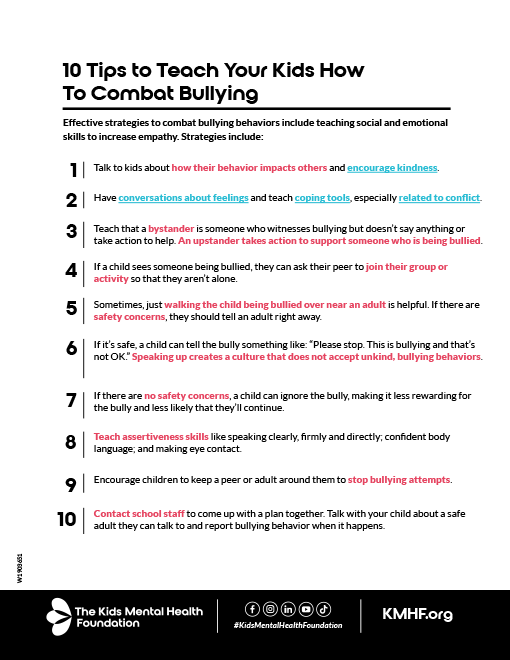- Bullying can stem from a child’s own emotional struggles, a lack of empathy, wanting control or past trauma. Children may also copy aggressive behavior they’ve seen at home, in school or in media.
- Kids who bully often face emotional challenges like low self-esteem, loneliness or depression, and are at higher risk for mental health concerns, including suicidal thoughts.
- Adults can support kids who bully others. Talk openly with your child and really listen. Show empathy in your own actions. Set clear and consistent rules. Work with teachers and schools to support positive behavior. Encourage healthy friendships and, when needed, reach out for professional help.
10 Ways to Combat Bullying
Article Summary
- Adults can teach children empathy, kindness and how to deal with their emotions early on to prevent bullying.
- Conversations about bullying should happen before issues arise.
- Encourage children to be upstanders by including others, telling bullies to stop (if it’s safe) and getting help from adults.
- If a child is being bullied, strategies like ignoring, assertiveness, using the buddy system and partnering with the school can help.
What is Bullying?
Intentionally hurting someone else verbally, socially or physically.
We know bullying can happen anywhere: at school, online or in the community. But to prevent bullying, adults must be proactive in teaching children positive social and emotional skills.
It’s also good to prepare your child for what they will do if they see bullying or if they are bullied themselves.
Don’t wait for bullying behaviors to happen to have conversations with children about bullying.
How to Prevent Bullying in Children
- Encourage kindness and empathy. Talk to kids about how their behavior and actions impacts other. Encourage kindness. Explain that children of different backgrounds can experience unfair treatment based on how they look.
Teach kids that by using kind words and including everyone, they help create a place where people feel accepted. For example, if a classmate is always left out of group activities or if someone is sitting alone at lunch, they can make a difference by asking their classmate to join their group of friends.
- Teach emotion regulation. Have conversations about feelings and teach coping tools, especially related to conflict. This will help children calm down instead of acting on strong emotions and mistreating their peers. Teaching self-control also helps students decrease impulsive behaviors and consider consequences for themselves and others.
Teaching Kids How to Respond if They See Bullying
- Strength in numbers: Kids tend to be bullied when they are by themselves. If a child sees someone being bullied, they can ask their peer to join their group or activity so they aren’t alone. They can also offer to walk with their peer between classes to make sure they’re not alone.
- Be an upstander, not a bystander: A bystanderis someone who witnesses bullying but doesn’t say anything or take action to help. An upstander takes action to support someone who is being bullied.
- Get help from an adult: Sometimes, just helping the child being bullied walk over near an adult is helpful. This way, the adult can see and hear what is happening and can intervene. A lot of children like this option because it keeps them from having to be “a tattletale.”
Remind children that if there are safety concerns, they want to tell an adult right away.
- Tell the bully to stop: If it’s safe, a child can tell the bully something like: “Please stop. This is bullying and that’s not OK.” Speaking up creates a culture that does not accept unkind, bullying behaviors.
What to Do If Your Child Is Being Bullied
- Ignore the behavior (if it’s safe). If there are no safety concerns, ignore the bully. Bullies often want a reaction. They’ll be less likely to continue if they don’t get a reaction.
- Teach assertiveness. Teaching children assertiveness strategies, such as telling the bully to stop, is another way to disarm the bully. Roleplay assertiveness skills. Practice speaking clearly, firmly and directly, confident body language, and eye contact with children so they are better prepared.
- Use the buddy system. There is often safety in numbers. Encourage children to keep a peer around them to stop bullying attempts. They can also stand near an adult so the adult can notice the bullying behaviors without the child having to “tattle.”
- Partner with the school. Contact the school staff to come up with a plan together. Many public schools are mandated to have a process to address bullying in their school. Talk with your child about a safe adult they can talk to and report bullying behavior when it happens. Make sure the adult is aware they are the child’s identified person.
Bullying can be painful—but with the right tools and support, children can learn to stand up for themselves and others. As caregivers, we can help build a culture of kindness and empathy.
 Copy Link
Copy Link




